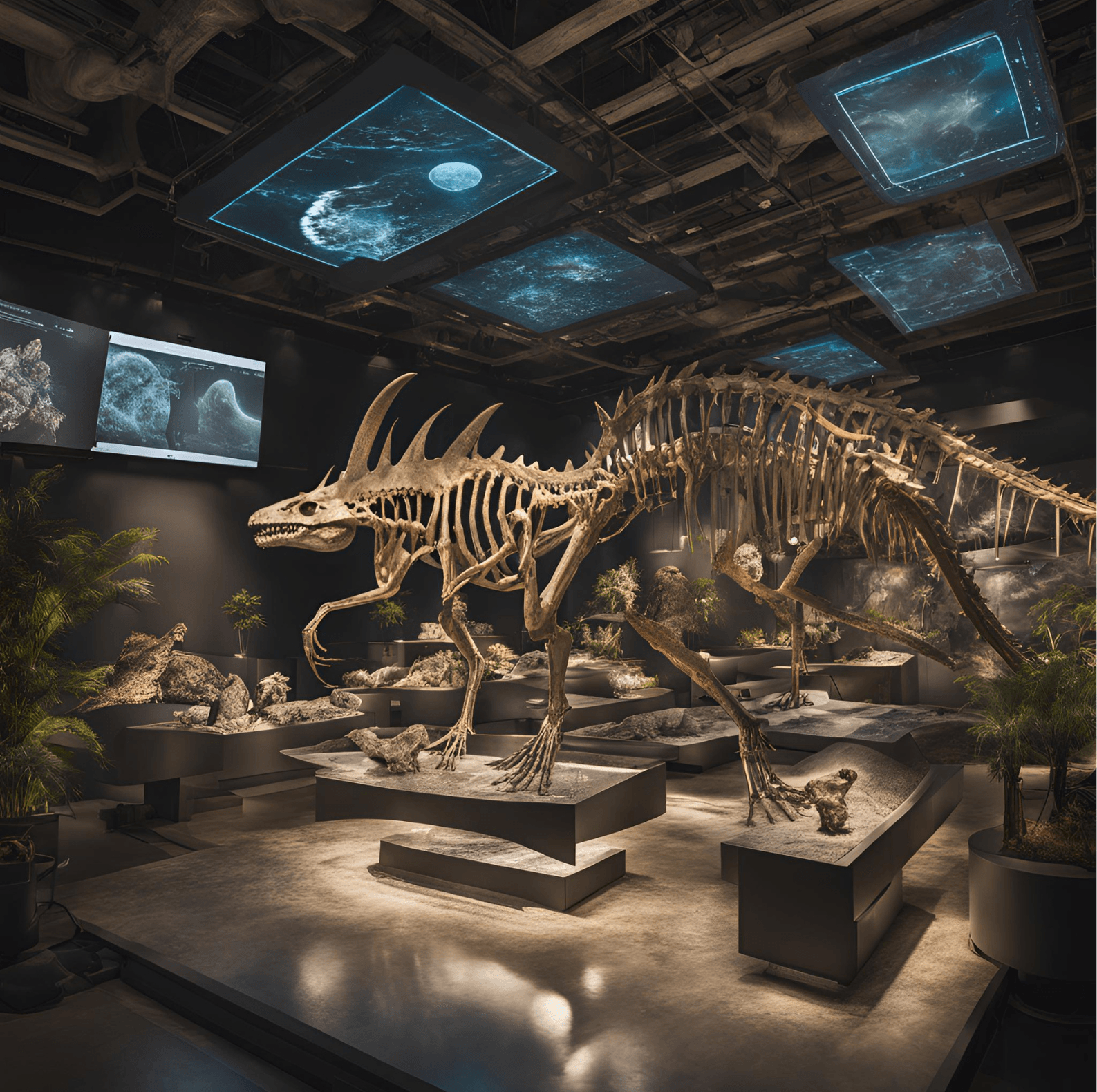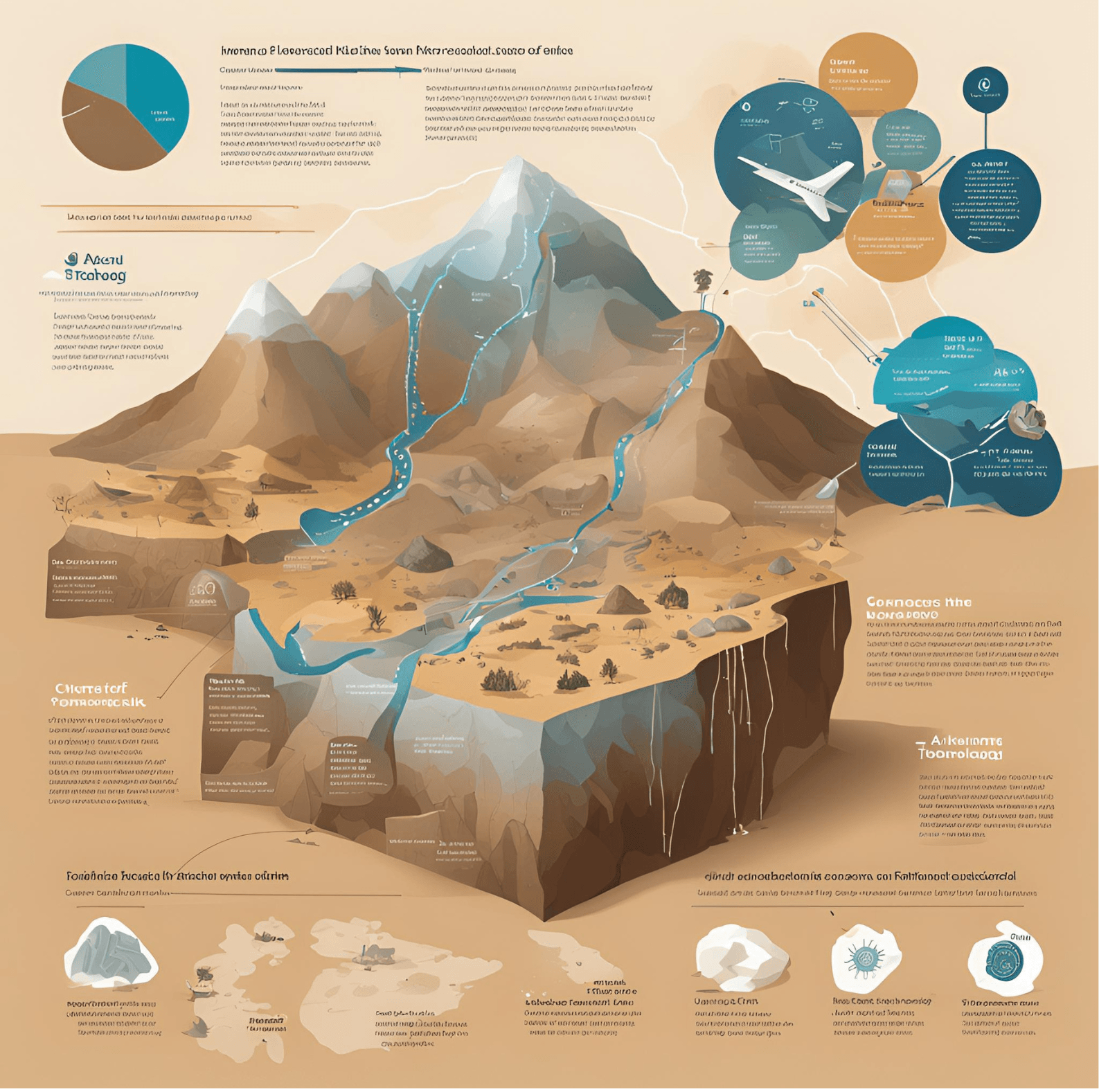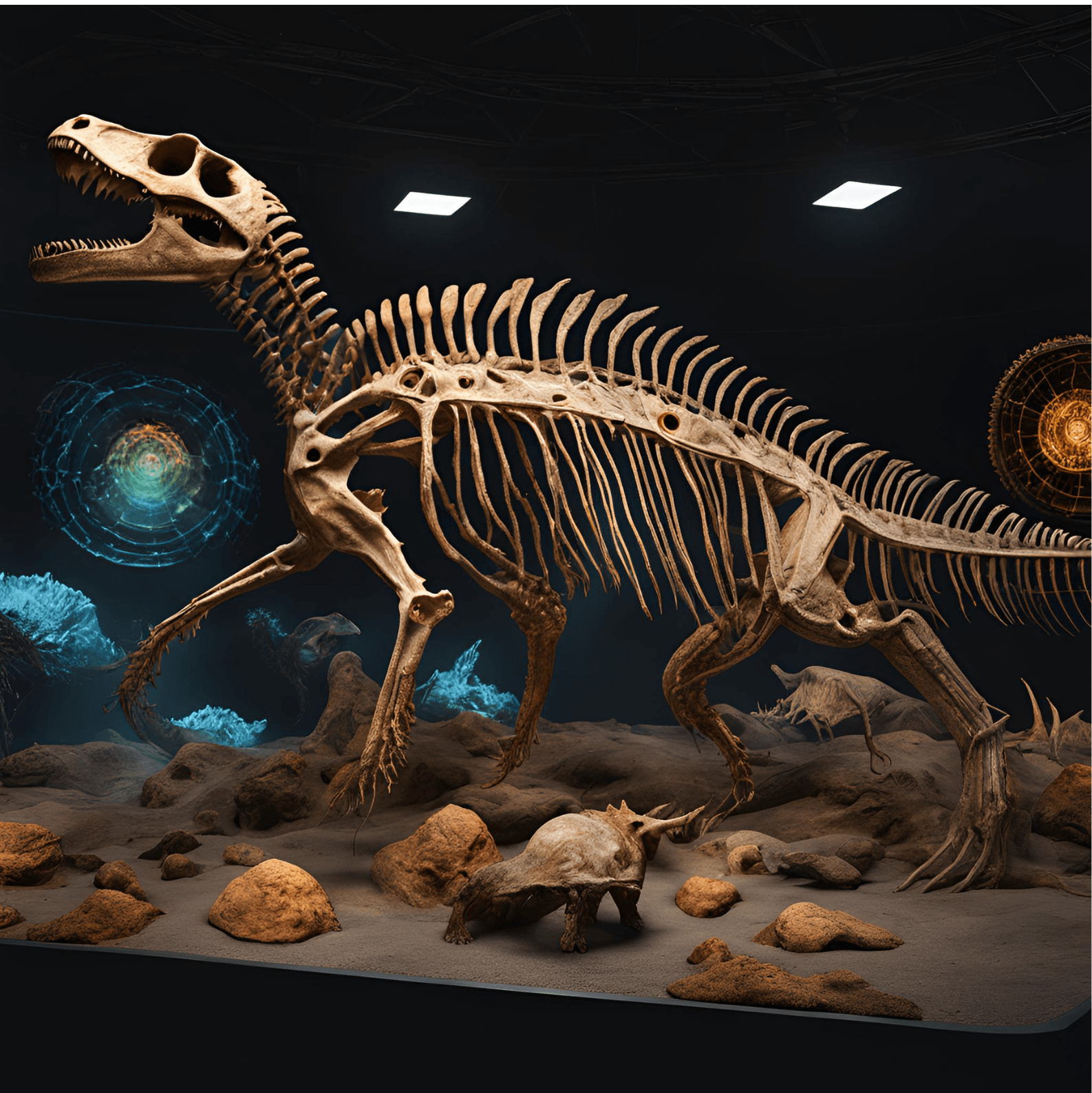Introduction: Revolutionizing Fossil Research with AI
Paleontology, the study of prehistoric life through fossils, has traditionally been a slow, methodical discipline, requiring years of meticulous excavation, classification, and comparative analysis. Discovering fossils often relies on educated guesses based on geological surveys, while reconstructing extinct species and their ecosystems demands extensive manual effort. However, advances in AI in paleontology are now transforming fossil research, allowing scientists to analyze vast datasets, predict fossil locations with greater accuracy, and even reconstruct ancient ecosystems through sophisticated modeling techniques.

The Role of AI in Paleontology: A Paradigm Shift
The role of AI in paleontology extends across multiple stages of fossil research, from site selection and excavation to classification and evolutionary analysis. Machine learning algorithms can now process complex geological data to pinpoint potential fossil-rich areas, significantly reducing the time and resources required for fieldwork. AI-powered image recognition systems can automatically classify fossils, accelerating what used to take months or even years of manual comparison.
Moreover, AI in fossil research is pushing the boundaries of traditional methods by reconstructing prehistoric organisms with remarkable detail. Through deep learning, AI can simulate extinct species based on fragmented fossils, offering insights into their possible behaviors, environments, and evolutionary significance. AI in archaeological science also assists in preserving and restoring delicate fossilized remains, ensuring that critical data is not lost to degradation over time.
AI is transforming paleontology by enabling researchers to accurately identify fossil-rich locations, reconstruct prehistoric environments, and classify specimens with unprecedented precision—paving the way for deeper insights into ancient life.
Applications of AI in Paleontology
AI in Fossil Prediction: Identifying Fossil-Rich Locations
Fossil hunting is historically a time-consuming process, requiring paleontologists to survey rock formations, analyze geological patterns, and make educated guesses about potential fossil sites. However, AI in fossil prediction is now revolutionizing site selection through machine learning and big data analysis.

AI algorithms analyze:
- Geological and Sediment Data: AI examines terrain composition, fossilization conditions, and erosion patterns to determine where fossils are most likely to be found.
- Climate and Environmental History: AI can reconstruct prehistoric climates and ecosystems, identifying areas that were once favorable for fossil preservation.
- Satellite Imaging & Remote Sensing: AI-powered satellite analysis detects subtle geological indicators of fossil presence, such as specific rock formations or mineral compositions associated with fossilization.
Example: A team of researchers at the University of Chicago used machine learning to analyze over 30,000 fossil records, predicting new fossil-rich sites with over 80% accuracy—a major breakthrough in excavation planning.
AI-Powered Fossil Analysis and Classification
Fossil classification is a painstaking task that requires specialists to manually compare newly discovered specimens with existing databases. AI is now automating this process through computer vision, deep learning, and image recognition technologies.
- Automated Identification: Neural networks analyze fossil morphology, instantly categorizing specimens by species, age, and evolutionary lineage.
- AI in Microfossil Study: AI-powered microscopes examine microscopic fossils, detecting minute differences invisible to the human eye.
- Cross-Referencing Fossil Data: AI compares new discoveries against global databases, identifying similarities and evolutionary relationships.
Example: Google’s DeepMind has developed AI models that can accurately classify fossilized bones, reducing misidentification errors and accelerating research by over 60%.
AI in Evolutionary Lineage Reconstruction
Understanding the evolutionary history of life on Earth requires mapping complex relationships between extinct and existing species. AI helps by:
- Predicting Missing Links: Machine learning analyzes fossil records, identifying potential gaps in evolutionary history.
- Reconstructing Prehistoric Environments: AI models simulate ancient climates, ocean currents, and ecosystems to determine how species adapted over time.
- Refining Phylogenetic Trees: AI-powered algorithms analyze genetic and fossil data to reconstruct accurate evolutionary trees.
Example: AI has been instrumental in confirming the link between dinosaurs and modern birds, identifying previously unknown transitional traits in fossilized remains.
AI is rapidly changing the field of paleontology, making fossil discovery, classification, and evolutionary analysis more efficient and accurate. AI-powered fossil analysis and AI in paleontological research provide invaluable tools for scientists, significantly accelerating discoveries that once took decades.
By leveraging AI in fossil research, paleontologists are now uncovering prehistoric mysteries at an unprecedented pace—reshaping our understanding of ancient life and the evolutionary history of our planet.
Notable Examples of AI in Paleontology
AI is driving groundbreaking discoveries in paleontology by automating data analysis, improving fossil identification, and enhancing simulations of ancient ecosystems. Here are some notable examples:
AI-Powered Fossil Identification and Classification
Traditional fossil classification requires meticulous manual study, but AI has revolutionized this process. Machine learning models, such as neural networks, analyze vast fossil datasets to identify subtle patterns that human researchers might miss. For instance, AI can differentiate between species based on minor variations in fossilized bones, helping scientists classify new species with greater accuracy.
AI-Predicted Fossil Sites
Using geological maps, climate data, and historical fossil records, AI can predict high-potential fossil-rich locations. Machine learning models like Random Forest and Support Vector Machines (SVM) analyze these datasets to suggest excavation sites, reducing the time and resources needed for fieldwork. One successful implementation involved AI predicting potential fossil sites based on satellite imagery, leading to significant discoveries.
AI-Driven 3D Fossil Imaging and Reconstruction
Fossil imaging has been transformed by AI, allowing for detailed 3D reconstructions. AI-powered tools use CT scans and deep learning to create highly accurate digital models of fossils, helping paleontologists study ancient species without the risk of damaging fragile specimens. AI has also been used to reconstruct missing fossil parts, predicting bone structures of extinct species based on related organisms.
AI Simulations of Prehistoric Ecosystems
AI-driven simulations have enabled scientists to recreate ancient ecosystems by analyzing geological and fossil data. By assimilating environmental factors such as climate and geography, AI can model how prehistoric species interacted with their surroundings, shedding light on extinction events and evolutionary patterns.
These examples illustrate how AI is reshaping paleontology, making fossil research faster, more accurate, and data-driven.
Challenges of Using AI in Paleontology
Despite its transformative potential, AI in paleontology presents several challenges, including technical, ethical, and professional concerns.
Data Quality and Model Accuracy
AI models require vast amounts of high-quality data, but fossil records are often incomplete or fragmented. Training AI on limited or biased data can lead to inaccurate predictions. Fossils can also degrade over time, making it difficult for AI to recognize patterns correctly.
Over-Reliance on AI vs. Human Expertise
While AI can speed up research, it lacks the intuition and contextual understanding of human experts. AI predictions need to be validated by experienced paleontologists, as misinterpretations of fossil structures can lead to false classifications or misleading evolutionary conclusions.
Ethical and Intellectual Property Concerns
Who owns the rights to AI-generated fossil reconstructions or discoveries? AI-driven models often use datasets compiled by human researchers over decades, raising questions about authorship and recognition. Additionally, AI automation may reduce the demand for skilled field paleontologists, shifting expertise from hands-on fossil analysis to computational data science.
Scalability and Cost
Implementing AI in paleontology requires significant computational power and financial investment. Many research institutions may lack access to the necessary infrastructure, limiting AI’s widespread adoption in fossil research.
While AI is revolutionizing fossil research, it is not without its challenges. The best approach is to integrate AI with traditional paleontological methods, ensuring that technology enhances, rather than replaces, human expertise.
The Future of AI in Paleontology
AI’s role in paleontology is rapidly evolving, and future advancements promise to further transform fossil research and our understanding of prehistoric life. Below are some key areas where AI is expected to drive progress:
AI-Driven Robotics for Automated Excavation
Traditional fossil excavation is time-consuming and requires skilled paleontologists. Future AI-driven robotic systems, equipped with machine learning and computer vision, could automate aspects of fossil excavation. These systems could analyze sediment layers, detect fossils with greater precision, and minimize damage to delicate specimens.
AR and AI-Enhanced Fossil Visualization
AI-powered augmented reality (AR) is set to revolutionize how we interact with fossils. Researchers and educators will be able to create interactive 3D reconstructions of prehistoric species, providing a more immersive experience. Museums and academic institutions may use AR applications to bring extinct creatures to life, helping audiences visualize them in their natural habitats.

AI in Genetics for Ancient DNA Reconstruction
With the integration of AI and genetic research, scientists are making strides in reconstructing ancient DNA sequences. AI can help predict missing genetic information, offering insights into the evolution of extinct species and their relationships with modern animals.
AI-Generated Prehistoric Storytelling
As AI’s ability to interpret fossil and geological data improves, it may be used to generate detailed reconstructions of prehistoric ecosystems. Machine learning models could create scientifically accurate narratives of how ancient species lived, hunted, and adapted to their environments. AI-driven simulations could allow for virtual exploration of prehistoric worlds.
The Ethical and Scientific Implications
As AI in paleontology advances, discussions around ethics and scientific integrity will become even more important. AI’s role should be to support and enhance human expertise rather than replace it. The integration of AI with traditional methodologies will be essential for preserving accuracy and ensuring that discoveries remain grounded in scientific evidence.
“As AI continues to evolve, its role in paleontology will extend beyond research, transforming the way we experience Earth’s ancient history.” AI-driven technologies are not just enhancing fossil studies—they are redefining how we uncover, analyze, and interact with prehistoric life.
Conclusion: Embracing AI in Paleontology
- AI’s Transformative Impact on Fossil Research
AI has already begun to revolutionize paleontology by improving fossil identification, automating analysis, and predicting fossil-rich sites. Machine learning algorithms, computer vision, and AI-powered simulations are accelerating discoveries that once took years of manual labor.
- Balancing AI with Human Expertise
While AI is a powerful tool, it must be used alongside traditional paleontological expertise. AI’s ability to recognize patterns and process large datasets is invaluable, but human intuition, experience, and fieldwork remain irreplaceable. The most effective research will come from a collaboration between AI-driven automation and expert paleontologists.
- Encouraging Further Research and Innovation
Paleontology is entering a new era, and researchers, students, and enthusiasts alike should explore the potential of AI-driven techniques. Funding and interdisciplinary collaborations between AI developers, data scientists, and paleontologists will be key in shaping the future of the field.
“By embracing AI, paleontology is not just preserving history but innovating for future discoveries.” AI is proving to be a game-changer in the study of prehistoric life, and its continued advancement will unlock even more secrets of our planet’s distant past
Related Articles You May Find Interesting
If you enjoyed learning about The Role of AI in Paleontology, you might also be interested in these articles:
- AI in Oceanography – Dive deeper into how AI is revolutionizing marine research, from deep-sea exploration to climate monitoring.
- AI in Everyday Life – Explore how artificial intelligence is shaping our daily routines, from smart assistants to automation.
- Agentic AI Systems – Learn about AI models that can operate autonomously and make intelligent decisions with minimal human input.
- AI in Wildlife Conservation – Discover how AI is being used to protect endangered species and monitor wildlife across the globe.
- Impact of Generative AI in Creative Industries – See how generative AI is transforming fields like art, music, and content creation.






